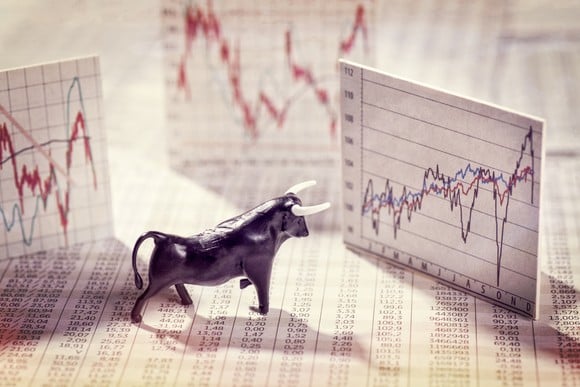Not everyone has time to constantly monitor the stock market, which is one reason passive investing through index funds is so popular. Rather than picking individual stocks -- which requires time, effort, and lots of experience -- investors can buy exchange-traded funds (ETFs) that track the performance of diversified American indexes like the S&P 500 (^GSPC 0.24%) and the Russell 2000.
Had you split $100,000 equally between those two indexes 30 years ago (and reinvested all dividends), you would be sitting on a whopping $1.7 million today:
Vanguard is one of the largest issuers of ETFs in the world. It offers the Vanguard S&P 500 ETF (VOO 0.28%), which tracks the S&P 500, and the Vanguard Russell 2000 ETF (VTWO 0.37%), which tracks the Russell 2000.
Here's how investing $50,000 into each of them today ($100,000 in total) could make you a millionaire over the next 30 years.

Image source: Getty Images.
The S&P 500 is America's most widely followed index
The S&P 500 has a very strict entry criteria. Companies must have a market capitalization of at least $20.5 billion, and they must be profitable over the most recent 12-month period. Even then, a special committee meets once per quarter to decide which companies make the cut.
The S&P is highly diversified, because its 500 constituents come from 11 different sectors of the U.S. economy. However, since the index is weighted by market capitalization, a handful of multitrillion-dollar companies (which operate in different segments of the tech industry) currently have a significant influence over its performance.
A group known as the "Magnificent Seven" currently makes up one-third of the entire value of the S&P 500 (and the Vanguard S&P 500 ETF):
|
Stock |
Vanguard ETF Portfolio Weighting |
|---|---|
|
1. Apple |
7.59% |
|
2. Nvidia |
6.60% |
|
3. Microsoft |
6.28% |
|
4. Amazon |
4.12% |
|
5. Alphabet |
4.04% |
|
6. Meta Platforms |
2.56% |
|
7. Tesla |
2.26% |
Data source: Vanguard. Portfolio weightings are accurate as of Dec. 31, 2024, and are subject to change.
Those seven stocks generated an average return of 60% in 2024, so they accounted for a significant portion of the 23% gain in the S&P 500:
The Magnificent Seven companies are leading different areas of the artificial intelligence (AI) race. Nvidia supplies the most advanced data center chips for AI development, and demand is significantly outstripping supply. Tesla, on the other hand, is building AI-powered autonomous software for self-driving vehicles. The company recently launched a driverless robotaxi called the Cybercab, which doesn't have pedals or even a steering wheel.
Those are just two examples. Looking beyond AI, I want to mention Warren Buffett's Berkshire Hathaway investment company because it's the only holding in the S&P's top 10 that is not directly tied to the tech industry.
That brings me back to the diversified nature of the S&P 500. A number of prominent companies sit just outside the index's top 10 holdings, including investment banking giant JPMorgan Chase, payments powerhouse Visa, and retail behemoths Costco Wholesale and Walmart.

SNPINDEX: ^GSPC
Key Data Points
The Russell 2000 is a highly diversified small-cap index
The Russell 2000 is home to approximately 2,000 of the smallest companies listed on U.S. stock exchanges. Like the S&P, its constituents also come from 11 different sectors of the economy, but this index is a little more balanced.
The Russell's largest sector is industrials with a weighting of 18.9%, followed by healthcare at 17.4%, and financials at 17.2%. Moreover, the top five holdings in the Vanguard Russell 2000 ETF represent just 2.1% of the total value of its portfolio:
|
Stock |
Vanguard ETF Portfolio Weighting |
|---|---|
|
1. FTAI Aviation |
0.53% |
|
2. Sprouts Farmers Market |
0.47% |
|
3. Insmed |
0.43% |
|
4. Vaxcyte |
0.37% |
|
5. Credo Technology |
0.34% |
Data source: Vanguard. Portfolio weightings are accurate as of Dec. 31, 2024, and are subject to change.
Most of the Russell 2000 companies are headquartered in America and conduct their business domestically, so the index stands to benefit significantly from falling interest rates and some of the policies the new presidential administration plans to impose (like tax cuts and tariffs).
Sprouts Farmers Market, for example, operates 410 grocery stores in 23 states across America, focusing on fresh and organic produce. Insmed, on the other hand, is based in New Jersey and makes medicines and therapeutics for rare diseases.
Since there is no overlap between the holdings in the S&P 500 and the Russell 2000, having exposure to both of them is a recipe for a highly diversified portfolio.

Image source: Getty Images.
How the two Vanguard ETFs could turn $100,000 into $1 million
The S&P 500 was established in 1957, and it has since delivered a compound annual return of 10.58%, assuming all dividends were reinvested. The Russell 2000 was established in 1984, and it has averaged an annual return of 7.96% including dividends.
Based on those figures, here's how much a $50,000 investment in each of them could be worth 30 years from now:
|
Index |
Compound Annual Return |
Starting Balance |
Balance in 30 Years |
|---|---|---|---|
|
S&P 500 |
10.58% |
$50,000 |
$1,021,568 |
|
Russell 2000 |
7.96% |
$50,000 |
$497,572 |
As you can see, a $50,000 investment in the S&P alone could make you a millionaire over the long term. However, the above figures don't account for the fees charged by ETF issuers like Vanguard.
The Vanguard S&P 500 ETF has an expense ratio of 0.03%, which is the portion of the fund deducted each year to cover management costs. That means a $50,000 investment will attract an annual fee of $15, but that figure will increase in dollar terms each year as the balance grows larger. For example, on a balance of $1 million, the 0.03% annual fee would be $300.
The Vanguard Russell 2000 ETF is slightly more expensive, with an expense ratio of 0.1%. That translates to an annual fee of $50 on the initial $50,000 balance.
Nevertheless, if both indexes maintain their average long-term returns, an investor would still become a millionaire after 30 years from their initial investment of $100,000.


